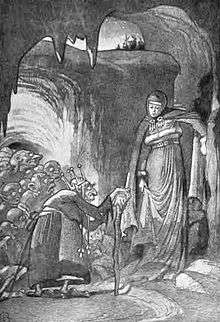Det sjungande trädet (opera)
Det sjungande trädet (The Singing Tree) Op.110 is an opera in two acts by the Finnish composer Erik Bergman. The Swedish-language libretto, based on a Swedish fairy tale, was written by Bo Carpelan. The opera premiered on 3 September 1995 at the Helsinki Opera House.
| Det sjungande trädet | |
|---|---|
| Opera by Erik Bergman | |
 1905 illustration from Prins Hatt under jorden, the Swedish fairy tale on which the opera is based | |
| Librettist | Bo Carpelan |
| Language | Swedish |
| Premiere | 3 September 1995 Helsinki Opera House |
Background and performance history
Det sjungande trädet was Bergman's only full-length opera and was composed between 1986 and 1988 as a commission from the Finnish National Opera.[1][2] Prior to that, the closest he had come to the operatic genre was his 1971 Samothrake Op. 69, a 12-minute "musico-dramatic tableau" for speaker, mixed choir, and dancers.[3][4] Carpelan's libretto is primarily based on the Swedish fairy tale, Prins Hatt under jorden (Prince Hatt under the Ground) which was in turn based on the ancient myth of Cupid and Psyche, but it also incorporates other elements from Swedish and Finnish folk tales.[1][5]
The opera had been originally commissioned for the opening season of the new Helsinki Opera House in 1993/94, but the complex structure of the work with 22 separate scenes, each with its own lighting and other technical requirements, led to a postponement of the premiere.[6] However, it was recorded in 1992 at Finlandia Hall conducted by Ulf Söderblom and released on the Ondine label later that year.[7] Bergman was awarded the 1994 Nordic Council Music Prize for Det sjungande trädet,[6] and it received its first staged performance on 3 September 1995 at the Helsinki Opera House as part of the Helsinki Festival, again conducted by Söderblom.[8][9] It was performed again in 1999 at the Deutsche Oper Berlin in a touring production by the Finnish National Opera.[10]
Roles
| Role | Voice type | Premiere cast, 3 September 1995[8] (Conductor: Ulf Söderblom) |
|---|---|---|
| The Princess | soprano | Kaisa Hannula |
| Prince Hatt | bass-baritone | Petteri Salomaa |
| The King | tenor | Peter Lindroos |
| The Witch | mezzo-soprano | Charlotta Hellekant |
| The Fool | baritone | Sauli Tiilikainen |
| Fruit seller | bass | Antti Suhonen |
| Servants, off-stage voices, chorus | ||
Synopsis
The opera's two acts are structured in a sequence of 22 tableaux with a prologue, interlude, and epilogue. They recount the story of Prince Hatt, who has been imprisoned underground by his aunt, the Witch, and is rescued by an unnamed Princess. The Princess first communicates with Prince Hatt by singing "The Tree of Life", which they both hear in their dreams. The Witch is ultimately destroyed by "the power of light" and the couple are united. However, the ending is not a completely happy one. The Princess is struck blind by the dying curse of the Witch.[1]
References
- Gramophone, Volume 70 (May 1993). "Bergman: The Singing Tree". Retrieved 17 February 2015 (subscription required).
- Anderson, Martin (9 May 2006). "Erik Bergman, Grand Old Man of Finnish music". The Independent. Retrieved 21 March 2015.
- Kaipainen, Jouni (1992). "Bergman's Grand Synthesis" Archived 2015-02-17 at the Wayback Machine. Nordic Sounds, Vol. 11, pp. 6–8
- Samothrake Op. 69 at AllMusic. Retrieved 4 July 2020.
- Korhonen, Kimmo (1998). "Erik Bergman in Profile" Archived 2015-02-17 at the Wayback Machine (English translation by Susan Sinisalo). Music Finland. Retrieved 17 February 2015.
- Beyer, Anders (1994). "In Search of Silence: A Meeting with Finnish Composer Erik Bergman" Archived 2015-02-17 at the Wayback Machine. Nordic Sounds, Vol 13, pp. 14–17. Online version retrieved 17 February 2015.
- Det sjungande trädet, recording 1992, OCLC 695921387
- Casaglia, Gherardo (2005)."Det sjungande trädet, 3 September 1995". L'Almanacco di Gherardo Casaglia (in Italian).
- White, John David; Christensen, Jean (2002). New Music of the Nordic Countries, p. 160. Pendragon Press
- Hanssen, Frederik (11 October 1999). "Die Finnische Nationaloper zeigt in der Deutschen Oper Berlin 'Der singende Baum'". Der Tagesspiegel. Retrieved 26 March 2015 (in German).